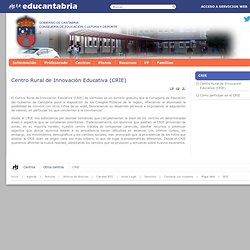

Moovly - Create Animated Content like a Pro. Spanish educational system. La OCDE. 1. texto-refundido-lomce-loe. Spain_organisation_of_primary_education. TIC. Estudio de un caso CRA ARIÑO-ALLOZA (TERUEL) Centro Rural de Innovación Educativa (CRIE) El Centro Rural de Innovación Educativa (CRIE) de Viérnoles es un servicio gratuito que la Consejería de Educación del Gobierno de Cantabria pone a disposición de los Colegios Públicos de la región, ofreciendo al alumnado la posibilidad de convivir con otros niños de su edad, favoreciendo su desarrollo personal e impulsando la adquisición de valores, en particular los que conciernen a la convivencia.

Desde el CRIE nos esforzamos por abordar temáticas que complementen la labor de los centros en determinadas áreas o aspectos que se consideren prioritarios. Tradicionalmente, los alumnos que asistían al CRIE provenían de zonas, en su mayoría rurales; nuestro centro trataba de compensar carencias, aportar recursos o potenciar aspectos que dichos alumnos debido a su procedencia tenían dificultad en alcanzar. Mapa conceptual. Mapa conceptual complejo.

Mapa conceptual es una técnica usada para la representación gráfica del conocimiento. Un mapa conceptual es una red de conceptos. En la red, los nodos representan los conceptos, y los enlaces representan las relaciones entre los conceptos. Aprendizaje significativo Según Novak, los nuevos conceptos son adquiridos por descubrimiento, que es la forma en que los niños adquieren sus primeros conceptos y lenguaje, o por aprendizaje receptivo, que es la forma en que aprenden los niños en la escuela y los adultos. Mind Mapping Programs. Mapa conceptual LOMCE definitivo. TPACK in 3 Minutes. Tpack.org. Technological Pedagogical Content Knowledge. Introduction[edit] Technological Pedagogical Content Knowledge (TPACK) is a framework to understand and describe the kinds of knowledge needed by a teacher for effective pedagogical practice in a technology enhanced learning environment.

The idea of pedagogical content knowledge (PCK) was first described by Lee Shulman (Shulman 1986) and TPACK builds on those core ideas through the inclusion of technology. Punya Mishra, professor, and Matthew J. Koehler, professor, both at Michigan State University, have done extensive work in constructing the TPACK framework. TPACK.org is an active repository of news and information about TPACK.
The TPACK Framework[edit] The TPACK framework argues that effective technology integration for teaching specific content or subject matter requires understanding and negotiating the relationships between these three components: Technology, Pedagogy, and Content. Scavenger hunt. A scavenger hunt is a party game in which the organizers prepare a list defining specific items, which the participants – individuals or teams – seek to gather all items on the list – usually without purchasing them – or perform tasks or take photographs of the items, as specified.[1] The goal is usually to be the first to complete the list, although in a variation on the game players can also be challenged to complete the tasks on the list in the most creative manner.

According to game scholar Markus Montola, scavenger hunts evolved from ancient folk games.[2] Gossip columnist Elsa Maxwell popularized scavenger hunts in the United States with a series of exclusive New York parties starting in the early 1930s.[3][4][5] The scavenger-hunt craze among New York's elite was satirized in the 1936 film My Man Godfrey, where one of the items socialite players are trying to collect is a homeless man.[6] Hide and seek (hideandandseek) Map projection. More generally, the surfaces of planetary bodies can be mapped even if they are too irregular to be modeled well with a sphere or ellipsoid; see below.

Even more generally, projections are the subject of several pure mathematical fields, including differential geometry and projective geometry. However "map projection" refers specifically to a cartographic projection. Background[edit] Maps can be more useful than globes in many situations: they are more compact and easier to store; they readily accommodate an enormous range of scales; they are viewed easily on computer displays; they can facilitate measuring properties of the terrain being mapped; they can show larger portions of the Earth's surface at once; and they are cheaper to produce and transport.
These useful traits of maps motivate the development of map projections. However, Carl Friedrich Gauss's Theorema Egregium proved that a sphere's surface cannot be represented on a plane without distortion. Hide and seek. Imagenes Sin Copyright. Creative Commons. YouTube. Textbook. A textbook or coursebook (UK English) is a manual of instruction in any branch of study.

Textbooks are produced according to the demands of educational institutions. Schoolbooks are textbooks and other books used in schools.[1][2] Although most textbooks are only published in printed format, many are now available as online electronic books. History[edit] The ancient Greeks wrote texts intended for education. The modern textbook has its roots in the standardization made possible by the printing press. The Greek philosopher Socrates (469–399 B.C.) lamented the loss of knowledge because the media of transmission were changing.[3] Before the invention of the Greek alphabet 2,500 years ago, knowledge and stories were recited aloud, much like Homer's epic poems. The next revolution for books came with the 15th-century invention of printing with changeable type. Compulsory education and the subsequent growth of schooling in Europe led to the printing of many standardized texts for children.